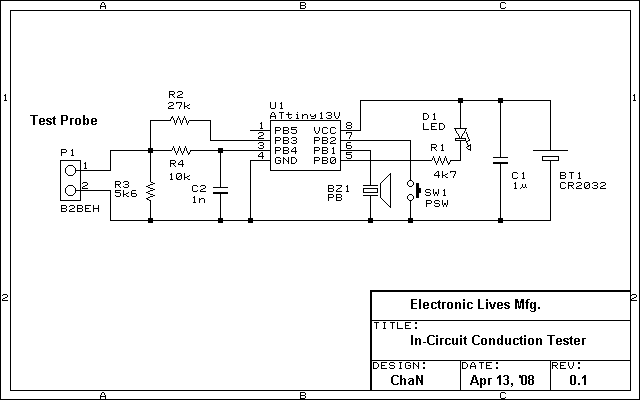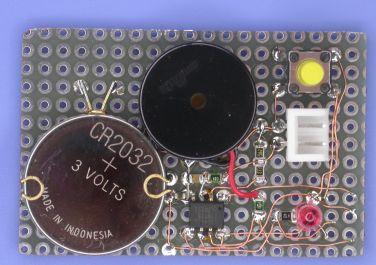 | ||||
HOME | ESR Meters | LCR Meters | Continuity-Low Ohm Meter |Geiger Counters | Tektronix | Metal Detectors | Contact Projects | Other Lab Tools | Solar | Master-Slave Switch | Semiconductor | ||||
 | ||
This is a conduction tester to check the connection on the built proto-board. Normally a circuit tester is used to check the conduction. But it is not suitable to check if wired or not in the circuit board with mounted parts because the semiconductor parts in the circuit become conductive under test voltage. Also the test voltage and current applied to the circuit can damage electrically sensitive parts. The in-circuit conduction tester can check pure conduction (wired or not) without those problem. There are some requirements and considerations for the in-circuit conduction tester described below. Correctness To avoid misjudgment, the test voltage appeared between the test probes is set as low as semiconductor parts keep non-conducive. Parts Safety To minimize risk of an electrical damage to the parts, test current is set low as possible. Indicator To improve job performance, the judgment should be indicated in a sound rather than meter or lamp to avoid to move view point between the circuit boad and the indicator. Durability The tester must not be broken easy by misoperations. A durability against hot circuit upto 24 volts is required at least. The firmware processes only a simple loop that reads A-D value and sounds a piezo buzzer. The beep tone varies depends on the resistance. When the resistance is larger than 5 ohms, the frequency start to lower and stopped at 45 ohms. Therefore it can detect a contact trouble by the beep tone. At power on (wakeup from sleep state), it tests output voltage and indicates the low battery status (blinking LED) when battery voltage is below 2.4V. When no conduction is detected for 5 minutes, it enters power off state. | ||
 | ||
/*-------------------------------------------------*/ /* In-circuit checker (C)ChaN, 2008 */ /*-------------------------------------------------*/ #include <inttypes.h> #include <avr/io.h> #include <avr/sleep.h> #include <avr/interrupt.h>
#define SYSCLK 128000 /* CKSEL[1:0]=11, CKDIV8=1 */ EMPTY_INTERRUPT(PCINT0_vect); void delay_ms (uint16_t dly) { uint8_t n, d;
do { n = 31; do d = PINB; while (--n); } while (--dly); } void beep (uint8_t t) { if (t) { OCR0A = t; OCR0B = t / 2; TCCR0A = _BV(COM0B1)|_BV(WGM01)|_BV(WGM00); t = _BV(WGM02)|0b001; } TCCR0B = t; } int main (void) { uint16_t ad, sdt; uint8_t lvd, n; static const int8_t tone[] = { SYSCLK / 4000, /* 0..5 ohm */ SYSCLK / 2640, /* 5..15 ohm */ SYSCLK / 1742, /* 15..25 ohm */ SYSCLK / 1150, /* 25..35 ohm */ SYSCLK / 760 /* 35..45 ohm */ }; PORTB = 0b00101; /* Initialize I/O port */ DDRB = 0b01011; /* BP0=LED, PB1=BZ, PB2=SW, PB3=Bias, BP4=ADC */ ACSR = _BV(ACD); /* Disable analog comp. */ PCMSK = _BV(PCINT2); /* Enable PCINT2 */ GIMSK = _BV(PCIE); sei(); set_sleep_mode(SLEEP_MODE_PWR_DOWN);
for (;;) { PORTB = 0b00101; /* LED OFF, Disable bias circuit */ ADCSRA = 0; /* Stop ADC */ while (bit_is_clear(PINB,PB2)) /* Wait for button released */ delay_ms(20); sleep_mode(); /* Enter Power-Down mode */ delay_ms(50); /* After leaving Power-Down mode, delay 50ms */ if (bit_is_set(PINB,PB2)) /* When it is accidental wakeup, re-enter Power-Down mode */ continue; PORTB = 0b01100; /* LED ON, Enable bias circuit */ ADMUX = _BV(REFS0)|0b10; /* ADC Ch=2, Vref=1.1V */ sdt = 0; /* Initialize shutdown timer */ while (bit_is_clear(PINB,PB2)) /* Wait for button released */ delay_ms(20);
ADCSRA = _BV(ADEN)|_BV(ADSC); /* Get Vbat (voltage on open circuit) */ delay_ms(1); ad = ADC; if (ad < 320) continue; /* When Vbat < 2.0V or probe shorted, shutdown */ if (ad < 384) lvd = 1; /* When Vbat < 2.4V, indicate LBT state (blink LED). */ else lvd = 0; beep(tone[0]); /* Startup beep */ delay_ms(100); beep(0);
do { ADCSRA = _BV(ADEN)|_BV(ADSC); /* Start conversion */ delay_ms(10); /* 10ms */ ad = ADC; /* Get input voltage */ if (ad < 5) { beep(tone[ad]); /* Start beep at frequency corresponds to the resistance */ sdt = 0; /* Clear shutdown timer */ } else { beep(0); /* Sto beep */ } if (lvd && ++lvd > 20) { /* Blink LED if needed */ lvd = 1; PINB = _BV(PB0); } } while (bit_is_set(PINB,PB2) && ++sdt < 30000);
if (bit_is_set(PINB,PB2)) { /* Beep on auto power off */ beep(tone[0]); delay_ms(500); } beep(0); } } | ||
 | ||
Elm-Chan In circuit Conduction Tester
April 2008 (Original here)